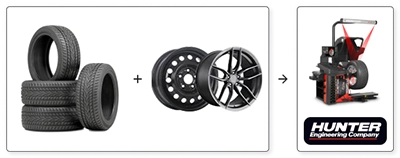Tips and tricks to get through winter in complete safety

In winter, road conditions are more hazardous and erratic, so it's crucial to adapt your driving accordingly. We thought it would be a good idea to give you some tips and tricks for winter maintenance and driving.
Maintenance
Is it essential to maintain tires?
Tire maintenance is primarily a matter of prevention. Indeed, wheel alignment prevents rapid, even premature, uneven and irregular wear of your tires. Unless there is an impact or a sudden change in your vehicle's behavior, which causes it to pull to one side or the other, it is generally recommended to align and rotate your wheels every 10,000 km. Please note that some tire manufacturers require that tires be rotated after 5,000 km for their warranty to apply.
Another aspect not to be neglected to optimize the life of your tires is the pressure. An under-inflated tire, even slightly, increases the risk of overheating or even bursting. In addition, tread wear is accelerated, and fuel consumption increases.
Conversely, the tread of an over-inflated tire wears out much faster, and the tire becomes very vulnerable to impacts, so it is risky to drive on a deformed road, debris or a pothole.
What about wheel care?
Although most cleaning products recommend using above 10°C, it is essential to wash your vehicle, even in winter. Snow, calcium, salt and dirt can eat away at metal, chrome and paint, causing rust problems on your vehicle and wheels. Ideally, choose a mild day, find a shelter, garage, car wash, underground parking lot, wash your vehicle, wax it and, most importantly, dry it. That way, you'll protect your car's paint and the finish on your wheels.
If you feel a vibration in your vehicle, check for snow or ice build-up in one or more of your wheels before rushing to your mechanic. If there is, clear the wheels and brakes, and everything should be back in order.
Winter Driving
You've been told many times that you need to slow down and keep a safe distance from the vehicle in front of you in winter, even if the road is dry. Why? First of all, the rubber of winter tires is softer than that of summer or four-season tires, which dramatically improves grip, but decreases road holding, especially in turns.
When you lose traction
If you feel your vehicle slipping under braking, don't "pump" the brake pedal, increasing the braking distance. Ideally, it would help if you pressed hard enough to slow down while avoiding triggering the ABS. This system, which releases and reapplies brake power dozens of times per second to prevent wheel lockup, also increases braking distance on snow or ice. You'll recognize it when it's triggered by an unpleasant return to the brake pedal.
The front or rear wheels can skid when you take a turn. As you approach a turn, the car wants to go straight. To keep your balance, slightly ease off the gas or brake pedal. This will put weight back on the front wheels, allowing them to turn.
On the other hand, if you feel the rear end losing traction, a slight acceleration will put weight back on the rear wheels and stabilize the car.
The tread pattern is designed to dig into the snow, reducing stability when cornering.
Also, if you have reduced the diameter of your wheels, as recommended, the sidewalls of winter tires are more prominent and softer to better grip the ice, which again reduces handling in turns.
In short, the advice is valid, regardless of the road conditions. So, slow down, especially in curves!
Tips and Tricks
Should I raise my windshield wipers in case of ice?
While it may seem like a good idea to raise your wipers when there is ice on the road to prevent damage, it is a bad idea. In fact, over time, this practice can reduce the pressure of the wipers on the windshield, leading to visibility problems.
It's best to leave the wipers in position and start the engine before you start plowing or scraping the vehicle so that the heater can de-ice the windshield and clear the blades of ice. If you are in a hurry or your car is not equipped with a remote starter, start by scraping the other windows or use a little windshield washer fluid or the mixture below.
An ultra-efficient de-icer recipe A mixture of water (1/3) and rubbing alcohol (2/3) is enough to remove the ice. However, it is essential to respect the recommended proportions for this mixture. Using only hot water would be a grave mistake, as it would simply crack the glass. Put the mixture in a spray bottle for an easy and practical application!
How do I keep my doors from freezing?
Not everyone is lucky enough to have a garage to park their car in. The cold, coupled with condensation, can make it difficult to open the doors. To avoid this inconvenience, you can put a thin layer of petroleum jelly (yes, good old Vaseline) on the sealing rubbers or spray them with a silicone-based lubricant. You don't need to put much on; you can even wipe off the excess and avoid getting dirty with the grease.
How to de-ice locks?
The «lock de-icer» should be kept outside the vehicle... Please put it in your briefcase, backpack, purse, diaper bag, or even in the kitchen drawer, but not in the glove compartment, where it will be inaccessible when the need to de-ice your locks arises.
As a preventative measure, you can lubricate the locks with a penetrating product such as WD-40 (but not Jig-A-Loo, which is sensitive to freezing).
What is the fastest way to de-ice the inside of windows?
Following a scientific method, Mark Rober tested (video). He proved that the most effective technique to defrost the inside of the windows is to turn on the heater to maximum, activate the air conditioner, select air circulation with the outside (not the inside) and open at least one of the windows.
To prevent fogging, which will turn into frost, you can use a stocking filled with clumping cat litter (which absorbs moisture) and wash the inside of the windows with a liquid anti-fogging treatment or shaving cream!


